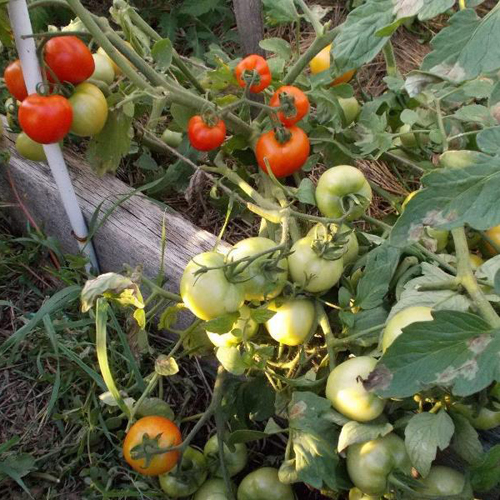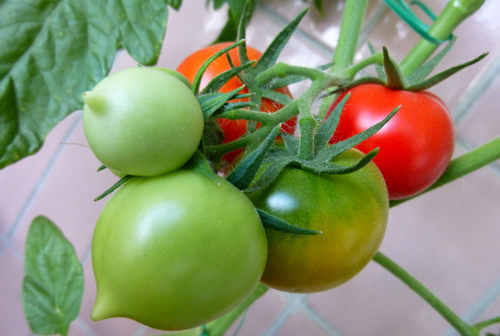Liang tomato variety
A classic example of an early-ripening tomato, which is good in a salad and does not fail in conservation, is the Liang variety. Moldavian breeders from the Transnistrian Research Institute of Agriculture really pleased. So many years have passed since its creation, and the tomato is still very popular not only in Moldova, but also in Russia and Ukraine. And this speaks of its reliability. The application for registration of the variety was filed in 1993, the date of entry into the State Register is 1996. The tomato is approved for cultivation in the following regions: Central, Central Black Earth, Volgo-Vyatka, Middle Volga, Ural, West Siberian and East Siberian. Designed for open ground. The official distributor of seed material is Argofirma Poisk LLC.

Description
The plant is short, determinate, but not standard. Height 35 - 40 cm. Lyana's growth is limited by the formation of a flower cluster. Moderate branching, good foliage. The leaf is ordinary, dark green in color, medium dissected, with a slightly corrugated surface. The size of the leaf plate is average. The inflorescence is compact, simple type. The first fruit cluster is laid quite early - above 5 - 6 leaves, then forms every 1 - 2 leaves. About 5 inflorescences are formed on the bush, containing from 3 to 5 ovaries. The peduncle of the variety has an articulation.
Lyana fruits are medium-sized, but they look very attractive - round, dense, fleshy, smooth. The skin is moderately hard, firm, glossy. At the stage of full ripeness, the tomatoes turn bright red. Fruit weight from 65 to 83 grams. The taste qualities of fresh tomatoes were unanimously assessed by the State Commission and ordinary gardeners as excellent. The number of seed nests in the pulp is 2 - 3 pieces. The seed yield is 0.30 - 0.35%. The juice contains: 4.3 - 5.0% dry matter, 1.6 - 2.0% sugar, 9.4 - 12.7 mg of ascorbic acid. The acidity of the juice is 0.48-0.80%.

Characteristics
- The variety is early maturing. The originators indicate that from the moment of emergence of full shoots to the beginning of maturation, 85 - 110 days pass. According to the State Register, in the Central region, the fruits ripen in 94 - 110 days, in the East Siberian region, the first harvest of tomatoes is ready for picking in 115 - 123 days;
- Liana's harvest begins to ripen together at the end of June - July, the fruiting period stretches until September. Of course, this process is significantly influenced by weather conditions;
- the yield of marketable fruits is quite high. Passing variety trials in different regions, the variety showed the following results: Central - 267 - 320 c / ha, which is 61 - 77 c / ha higher than the standards of Peremoga 165 and White filling 241; East Siberian - 456 c / ha, which exceeded the standard Siberian early maturing by 228 centners / ha. In the Republic of Khakassia, the maximum yield was shown - 713 c / ha, which exceeded the standard by 418 c / ha. From an ordinary garden bed, gardeners can get from 4.5 to 7 kg of tomatoes from 1 square meter;

- breeders managed to instill in Lyana high resistance to top rot of fruits, macrosporia and bacterial spotting. The variety is moderately susceptible to septoria and late blight. Poor resistance to tobacco mosaic virus;
- due to the dense structure of the pulp, tomatoes perfectly withstand transportation over long distances;
- keeping quality is also good if storage standards are observed;
- the way of eating fruits is universal. They are great for salads, processing into tomato products, pickling, pickling. The dense skin withstands heat treatment and does not creep when canning.
Agrotechnics
Growing Liang is pretty easy. It is best to do this in a seedling way. But you can sow tomato seeds directly into the ground, for this you need to wait until the ground warms up to 12 ° C, which will happen in late April - early May. Sowing for seedlings is carried out 60 - 65 days before the intended transplantation into the ground. The usual terms are March - April, in the southern regions the date may be shifted by a week, that is, to the end of February. Before planting seedlings in the ground, they are hardened.The variety is planted according to the standard scheme - 40 × 50 cm. The density of placement per 1 square meter is up to 6 plants.
To obtain an earlier and large-fruited harvest, the bush is formed into 1 - 2 stems, removing the rest of the stepsons. But many gardeners either remove stepchildren to the first inflorescence, or do not do pinching at all. Thus, the overall yield increases, and ripening, although it takes longer, is quite insignificant. Despite its short stature, a week or two after transplanting into the ground, the plant must be tied to a support. Otherwise, knotted tomatoes will twist and overwhelm the stem. The rest of the care is common to the culture as a whole.
Are there varieties?
Thanks to the success with gardeners, all sorts of varieties of this tomato began to appear on the seed market, for example, Liana pink, raspberry
This variety is an excellent example of combining early maturity, yield and great taste. Housewives are trying to purchase this particular tomato for processing and canning. Ease of care during cultivation greatly facilitates the work of the gardener. But there is a risk of buying a re-grading instead of the real Liana. Because of this, the first impression of acquaintance with the variety can be negative, so be extremely careful when purchasing seed.









In May last year, I bought Lyana's seedlings, and in the second half of June I ate fresh tomatoes. Moreover, they grew in my open field. Small in size, they fit well in jars, so some of the fruits are pickled. Also used for salads.
This year I grew tomatoes from seeds. I bought both red and pink varieties. In February, she sowed it into the ground, and in May she again transplanted it to the garden bed. But this year Lyana and I were not lucky. Due to heavy rains, all my seedlings died from late blight.
I chose this variety for the first year of container gardening because it showed itself well in the ground. Grown through seedlings to get the harvest early. For each bush - a container - 10 liters, led in three trunks, since the variety is undersized. Many steams - plucked once a week. The brushes turned out to be even, on average 4-5 tomatoes, they ripened gradually. I fed only with organic fertilizers, a little more often than in the ground. Traditionally resistant to phytophthora, it tolerated drought and blockage well. The last tomatoes were removed in August.
I have been growing this variety for several years. I like Liang for a good yield. The bushes are not tall, but very spreading and dense. They require a garter not because of the size of the bush, but because of the size of the numerous clusters (5-7 fruits each). Therefore, I had to tie up almost every bunch, otherwise they broke. Moreover, with my frequent watering, the size of the fruits was larger than this variety should have. All fruits are the same, so the variety is great for canning. Average taste. It is resistant to diseases, although it was still sprayed from phytophthora.It was difficult to do this because of the large density of the bushes.
Lyana is a time-tested tomato, quite unpretentious. Fruits are smaller than average, very productive and short. Tomatoes can be grown in a seedless way. About only a week later, they begin to bear fruit than those planted with seedlings. Does not require a garter and formation of bushes.
The first time I planted such tomatoes and did not know what would happen. In the conditions of our climate, they sowed on seedlings, and then in a greenhouse.
I was delighted! The seedlings are strong, the leaves are good, they were transplanted into the greenhouse without problems and immediately began to develop well. Literally 3 weeks after the transplant, the first flowers were set, and since we had a good summer, they were well pollinated and tomatoes were set.
The fruits are very tasty, we ate part of them fresh (sometimes we ate straight from the bush), and part of them prepared in our own juice for the winter and made lecho from them.
Good variety, I will plant more.